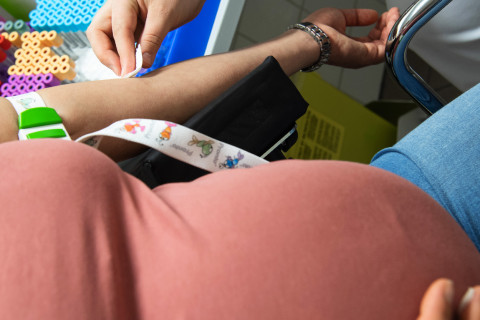The doctoral dissertation in the field of Paediatrics, Obstetrics and Gynecology will be examined at the Faculty of Health Sciences at the Kuopio Campus.
Alcohol use during pregnancy causes a spectrum of harmful effects to the pregnant mother and exposed children, according to the doctoral dissertation of Anni Lehikoinen, Licentiate of Medicine. “There is still no reliable method to detect alcohol use during pregnancy. However, optical coherence tomography of optic nerve thickness could possibly be used as a detection tool for fetal alcohol exposure,” Lehikoinen says.
Fetal alcohol spectrum disorder (FASD) is an umbrella term that describes all fetal alcohol effects. The FASD includes fetal alcohol syndrome (FAS), fetal alcohol effects (FAE), fetal alcohol-related neurodevelopmental disorder (ARND) and alcohol-related birth defects (ARBD). Despite the known adverse effects of alcohol use during pregnancy, we lack a reliable way to detect fetal alcohol exposure. The purpose of the doctoral study was to investigate the effects and long-term sequelae of alcohol use during pregnancy.
Alcohol and drug abuse changes pregnant mothers’ metabolite profile
The researchers studied metabolomics and trisomia screening parameters of alcohol- and drug-abusing pregnant mothers as well as non-abusing mothers during the first trimester. According to the results, the metabolite profile of alcohol- and drug-abusing mothers seemed to differ from that of non-abusing mothers. Alcohol- and drug- abusing mothers had increased glutamate and decreased glutamine levels, and alcohol use was associated with decreased serotonin levels. However, the first trimester screening parameters (free β-hCG, PAPP-A and NTT) for trisomy 21 were not affected by alcohol and drug abuse. However, smoking increased free β-hCG levels and decreased PAPP-A levels. In addition, mothers giving birth to a child small for gestational age showed decreased PAPP-A levels.
“The metabolite profile changes observed in the study cannot be used in practice to detect alcohol use during pregnancy, as further research is still needed,” Lehikoinen points out.
The study also investigated alcohol- and drug- exposed fetuses during the second trimester of pregnancy by ultrasonography and followed their outcome at the age of 2.5 years. Smaller head size was associated with alcohol and drug exposure. Head circumference and height of exposed children remained reduced compared to the population reference at 2.5 years of age.
Children diagnosed with FAS or FAE show alterations in brain structures and neurotransmitters at school age
Head MRI and SPECT imaging was performed in children with FAS or FAE at school age. In addition, ophthalmological examination was performed in young adults diagnosed with FAS or FAE as children. MRI showed smaller absolute volumes of the amygdala, caudatus, putamen and hippocampus in FAS/FAE children than in controls. SPECT imaging using a specific radioligand showed reduced serotonin transporter (SERT) and increased dopamine transporter (DAT) binding in striatal nuclei of FAS/FAE children. “These findings indicated similarities with alcohol dependency characterized by antisocial, impulsive, and aggressive personality and early-onset alcohol dependence,” Lehikoinen says.
Additionally, when examined as young adults, reduced optic nerve thickness on optical coherence tomography (OCT) was found, which is in line with previous animal and human studies. “Fetal eye development starts at three weeks and continues throughout the pregnancy. Therefore, alcohol exposure can impair eye development at all stages of pregnancy. Indeed, fetal alcohol exposure is often associated with ocular abnormalities.”
The doctoral study increases understanding of the structural and biochemical changes in alcohol-using mothers and their children. However, according to Lehikoinen, further research is needed to find a reliable way to detect alcohol use and to control for confounding factors.
The doctoral dissertation of Anni Lehikoinen, Licentiate of Medicine, entitled Fetal alcohol exposure: biochemical findings and insights into clinical outcome will be examined at the University of Eastern Finland. The Opponent in the public examination will be Docent Ilona Autti-Rämö of the Ministry of Social Affairs and Health and the University of Helsinki, and the Custos will be Professor Jarmo Jääskeläinen of the University of Eastern Finland.
Doctoral defence online (in Finnish)
For further information, please contact:
Anni Lehikoinen, Lic Med, anni.lehikoinen (a) kuh.fi



